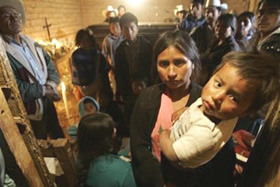 |
 |
 |
 News Around the Republic of Mexico | January 2006 News Around the Republic of Mexico | January 2006  
Mexico Using New Database to ID Migrants
 Olga R. Rodriguez - Associated Press Olga R. Rodriguez - Associated Press


| | Nieves Olea Cano, right, stands with some of her eight children next to the coffin of her late husband, Santiago Mendoza Galvez, 34, during the wake in the town of Metlatonoc, Mexico on Friday Jan. 19, 2006. Galvez, who had left for the United States in search of work, died after he was run over by a car while working illegally in Dotham, Alabama last Dec. 18. (AP/Dario Lopez-Mills) |
Monterrey, Mexico - Jose Arnulfo Cuenca was supposed to call his wife when he reached New Jersey, after sneaking into the United States through the Arizona desert. She's been waiting for that call since October.

Cuenca went missing after the group of 50 migrants he was traveling with scattered to hide from the U.S. Border Patrol. No one has seen him since, according to his 18-year-old daughter, Berenice Cuenca, who was traveling with him.

His wife, Sofia Flores, printed hundreds of fliers with her husband's photo and sent them with other migrants heading to the United States, hoping someone might have information.

That didn't work, though, and now she has turned to a new Mexican government program designed to help identify migrants who die crossing the border - as well as find the living who lose touch with family once they are in the United States.

In the last decade, more than 3,000 migrants have died trying to sneak into the United States. Of those, at least 1,000 remain unidentified and many are buried in pauper graves in cemeteries along the border, Mexican officials say.

Other migrants disappear into new lives, using false names and leaving behind relatives in Mexico who may not have phones or may be difficult to contact.

The government's new program, known as the System for Identifying Remains and Locating Idividuals, links the Foreign Relations Department's 35 offices in Mexico and 45 consulates in the United States to an Internet database.

The offices will be able to feed the database with photos and information, including tattoos and birthmarks, that might help officials find those missing or identify the dead, said Marco Antonio Fraire, a spokesman for the program.

"We want to help people who have lost a loved one to close such a dramatic chapter in their lives," he said.

Fraire said the database, started last June, has the capacity to store 2.5 million records, including information on those with passports or identification cards from Mexican consulates.

Flores said her husband, a 44-year-old fruit and vegetable vendor, wasn't carrying identification or a passport. So she filed a form with the Foreign Relations Department's office in central Puebla state describing him as a chubby, short man, with a scar on his face and part of a front tooth missing.

For the DNA portion of the program, Mexico signed a contract with Lori Baker, a forensic anthropologist at Baylor University in Waco, Texas. Baker is working on collecting DNA samples from the remains of 100 migrants who died during the last two years. That information will be added to the database.

If there is evidence linking the remains to a missing person report, then Baker will obtain DNA information from relatives through mailed-in blood samples.

"It's a step in the right direction," Baker said. "After a year of working on this database, it may become a very effective way to give some families closure."

Many of the bodies of migrants found along the border are buried in unmarked graves.

Fraire said that due to the high cost of running DNA tests, bodies will only be exhumed if officials have evidence that could lead to an identification.

The identity of many of the dead migrants may never be known because coroners in most U.S. border states have not been required to collect DNA samples. California started requiring its coroners to keep DNA samples in 2001, but DNA testing remains optional in Texas, New Mexico and Arizona.

Jesus Torreblanca, who received Sofia Flores' report at Puebla's Migrants Commission, believes the husband is dead.

"We still hope to find him alive, but because of his age and the fact that this was Mr. Cuenca's first trip through the desert, we fear the outcome may be bad," Torreblanca said.

But until Flores is shown her husband's body, she will keep searching.

"As long as he's hasn't been found dead in the desert or in a hospital, I'll have hope that we'll find him," Flores said. "Sometimes I wonder whether it is sadder to have a tomb where I can cry over his death or keep wondering where he could be." | 
 | |
 |



